Kratom Drug Interactions: How It Interacts With Other Medications
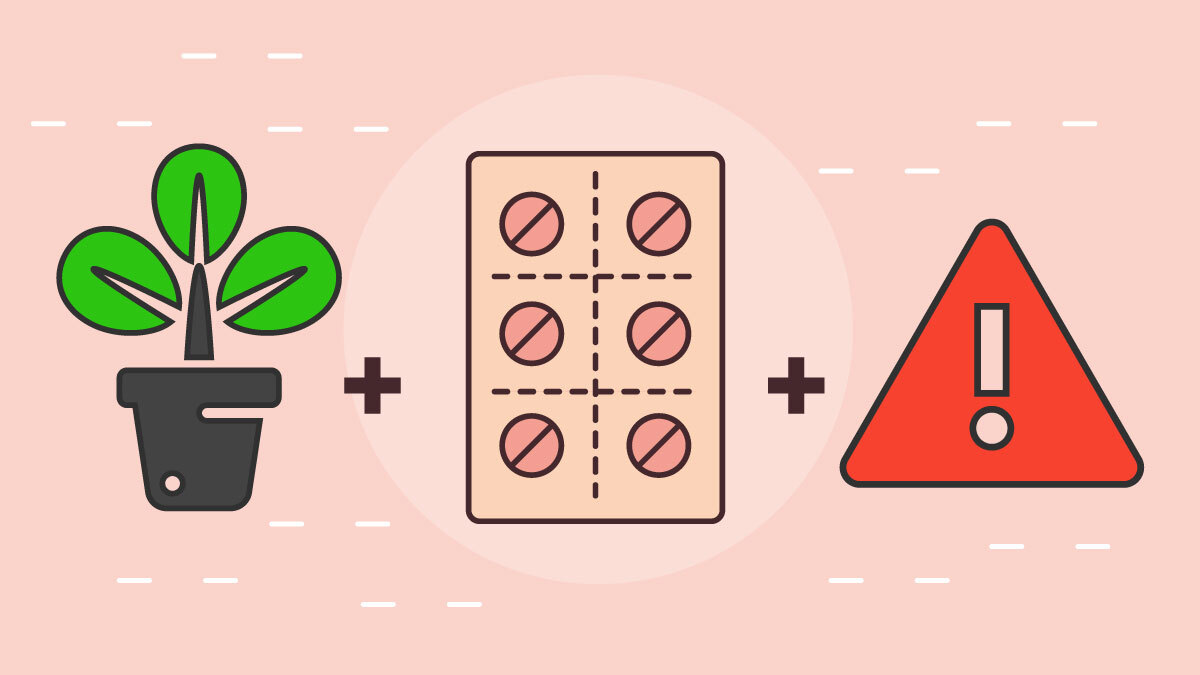
Kratom is a psychoactive substance, meaning it affects the normal functioning of the brain and the rest of the body. Using it responsibly is key to getting the most out of its benefits, and this includes knowing the right kratom dosage and how it interacts with other substances, including medications.
Throughout this article, you will learn whether it’s safe to mix kratom with various substances and their potential risks. Lastly, we will list numerous medications and explore how the herb interacts with them.
Taking Kratom With Medications & Other Substances
Like many other herbal extracts, kratom is safe when taken alone. Nevertheless, you might wonder how to take kratom properly and what happens when or if you mix it with other substances, like tea, coffee, or a specific medication.
In reasonable amounts, taking kratom with tea or coffee is harmless. Many people already use them to potentiate the herb’s effects or to mask its harsh taste.
Our advice is the opposite regarding medications: do not take them in conjunction with kratom. Kratom affects the body in many ways, from neurochemical balance variations to liver metabolism changes. There are hundreds of medications that could conflict with it.
Moreover, all these medications carry side effects, as does kratom, and their combination could cause severe to fatal outcomes. Unless your doctor says you can do otherwise, you should never take medications and kratom together.
Types of Kratom Drug Interactions
Depending on the drug or medication, kratom will interact with it in three different ways. The first two relate to the potency of the effects. Meanwhile, the latter is about metabolism and the time it takes for the body to eliminate both substances.
1. Agonistic Interaction
Depending on the dose taken, kratom can provide effects similar to other medications. If taken together, the results can increase in potency, which has many risks.
In low amounts, kratom is a stimulant. Taking it with other stimulants like Modafinil could easily result in insomnia and gastrointestinal discomfort. Moreover, it could also increase the risk of heart damage or strokes.
When using kratom as a sedative, combining it with other drugs or medications of the same kind could lead to a much more potent sedative effect. That would show as a feeling of drowsiness, which could be dangerous if the user has to drive or be responsible for others. Respiratory depression is another danger when mixing kratom with sedating drugs.
2. Antagonistic Interaction
A substance is antagonistic when it stops or lessens the effects of another. In kratom’s case, this occurs when a user takes it with a medication that has the opposite effect, reducing or even canceling the medication’s purpose.
Once the medication stops working as it should, the condition’s symptoms would emerge again, with severe consequences for the patient depending on the issue.
3. Metabolic Competition
The liver’s cytochrome P450 enzymes are responsible for the metabolism of most drugs. There are several varieties, each designed specifically to dissolve distinct types of molecules.
Five enzymes are responsible for the metabolism of around 70% of all drugs and medications: CYP3A4, CYP2D6, CYP1A2, CYP2C9, and CYP2C19 [1]. Most kratom alkaloids have an affinity for these, especially CYP2D6, 2C9, and 3A4 [2,3].
If the body has two substances — in this case, kratom and a drug — that require the same metabolic path, they will compete with each other for the enzymes. As a result, the elimination rate will be slower for both of them, letting them last longer in the bloodstream.
This type of interaction isn’t necessarily dangerous if it only happens occasionally. However, with some drugs, it only takes once. Other medications don’t do damage unless this combination occurs daily. In that case, the body doesn’t have enough time to clear the substances from the bloodstream. Then, their levels build up until they become toxic, resulting in side effects or an overdose.
Kratom Interactions With Common Substances
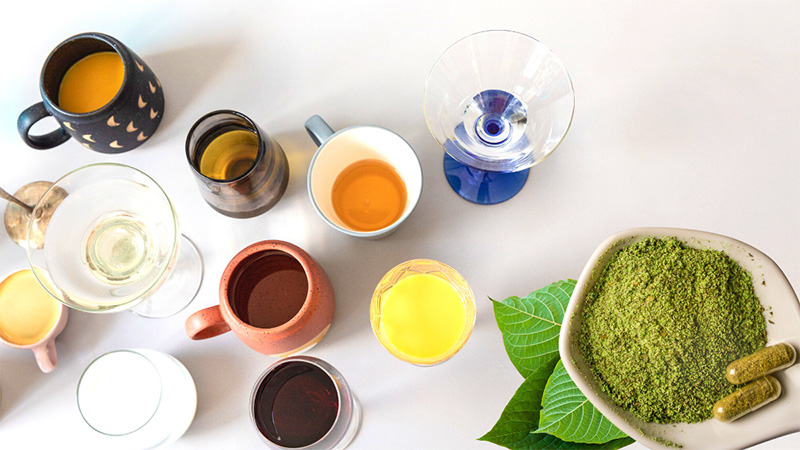
The list below will give you an idea of what to expect when taking kratom with popular substances like tea or alcohol. While some combinations are harmless, others could have consequences for your body, so remember to take them responsibly.
Green & Black Tea
Tea is one of the most popular beverages in the world. It comes from boiling the leaves of the tea plant (Camellia sinensis) and has several variants, including black, green, and white tea. It also contains a considerable amount of caffeine and is an excellent natural stimulant.
Kratom can also act as a stimulant, and in lower doses, it can be agonistic and potentiate the energy boost of caffeine. Many users also mix their kratom powder with green tea to lessen the powder’s bitter taste.
Nevertheless, while lower doses might be beneficial, avoid taking heavy kratom doses with tea. If you’re willing to try the combination, start with a small amount and increase it slowly.
Orange Juice
Many people use orange juice as a kratom potentiator and as a way to mask the powder’s harsh taste. While orange juice and kratom don’t interact much, kratom’s effects may become mildly more potent.
Orange juice increases the metabolic ratio of CYP3A4 by 7%, but research hasn’t yet found a significant change in the metabolism of substances that use that enzyme, such as kratom [4]. Still, there’s no specific research on the link between kratom and orange juice.
Kratom potentiators increase the risk of side effects, but in the case of orange juice, that risk is low. Most likely, this combination could end in nausea, dizziness, and headaches. If they happen, we recommend you take a break from these two substances.
Alcohol
We don’t recommend mixing kratom with alcohol. Both substances have somewhat similar effects, and their combination can lead to dangerous side effects like dizziness and vomiting. In addition, their combined stress on the liver could damage it beyond repair.
Moreover, kratom and alcohol are diuretics, meaning they increase the rate of urination, dehydrating the body. Furthermore, continued use could lead to dependence and addiction.
Coffee
Coffee is highly stimulating due to its levels of caffeine and has effects similar to kratom. Though they act on different receptors, they are agonistic, meaning their effects can potentiate depending on the dose.
In small doses, kratom can enhance the effects of coffee. The side effects of taking them together won’t be dangerous, but that doesn’t mean you should mix them without care.
If you want to take a high amount of kratom, you should take both substances at different times. This combination could worsen anxiety and hypertension, so you should avoid it if you have these conditions.
Kratom & Prescription Medications
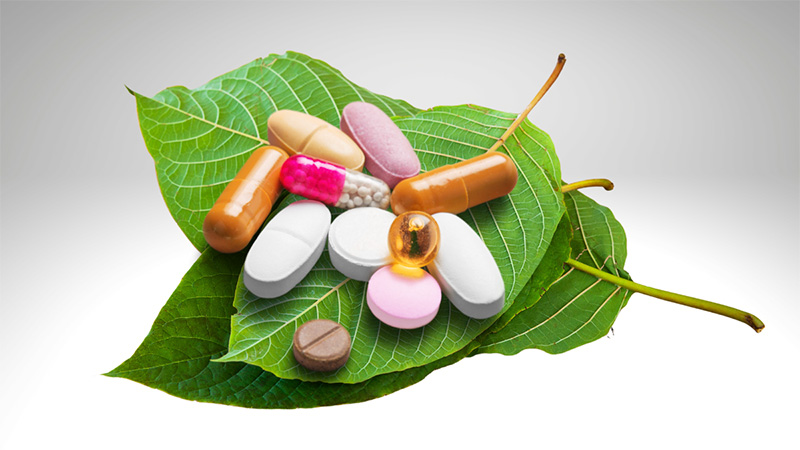
Below, we will list different medications and examine how kratom interacts with them. However, keep in mind that research on kratom interactions is still quite limited, and some of the following information lacks actual studies.
5-Alpha-Reductase Inhibitors (5-ARIs)
5-alpha-reductase is an enzyme that catalyzes the production of dihydrotestosterone (DHT). Doctors prescribe 5-ARI medications to treat benign prostatic hyperplasia and male pattern baldness, which are believed to be caused by a higher-than-average DHT.
There’s a low risk of interaction between kratom and 5-ARIs. However, the CYP3A4 enzyme metabolizes both substances, which may result in their slowed elimination [5]. In the long term, this could cause side effects.
The side effects of taking kratom with 5-ARIs might include skin rashes, reduced libido, and increased breast size.
Some common 5-ARI medications include:
- Alfatradiol (Ell-Cranell Alpha & Pantostin)
- Dutasteride (Avodart)
- Epristeride (Aipuliete & Chuanliu)
- Finasteride (Proscar & Propecia)
- Saw Palmetto Extract (Permixon)
ACE Inhibitors
Angiotensin-converting enzyme (ACE) inhibitors are medications that stop the production of a hormone called angiotensin II. As a result, blood pressure lowers while vessels expand, treating symptoms of hypertension, diabetes, heart disease, and more.
Kratom shouldn’t be used in tandem with ACE inhibitors. The herb could increase blood pressure, counteracting the medication’s benefits and raising the risk of fatal complications. Adverse reactions include strokes, heart attacks, and even death.
Some common ACE inhibitors include:
- Benazepril (Lotensin)
- Captopril (Capoten)
- Enalapril / Enalaprilat (Vasotec)
- Fosinopril (Monopril)
- Lisinopril (Zestril and Prinivil)
- Moexipril (Univasc)
- Perindopril (Aceon)
- Quinapril (Accupril)
- Ramipril (Altace)
- Trandolapril (Mavik)
Alpha-Blockers
Alpha-blockers stop the blood vessels’ adrenergic receptors from activating. Their purpose is to reduce blood pressure, but they also are good at improving urination in men with prostate issues.
Kratom and alpha-blockers have a moderate to high risk of producing an antagonistic interaction. Stimulants like kratom or coffee activate the adrenergic receptors, narrowing the blood vessels and increasing blood pressure, negating the effects of the alpha-blockers.
The decrease in blood pressure caused by these medications can treat hypertension and prevent strokes, so the consequences of taking both substances could be fatal. Don’t take kratom if you use alpha-blockers.
Some common alpha-blockers include:
- Carvedilol (Coreg)
- Doxazosin Mesylate (Cardura)
- Prazosin (Minipress)
- Terazosin (Hytrin)
Alpha-Glucosidase Inhibitors (AGIs)
Alpha-glucosidase is an enzyme responsible for turning carbohydrates into simple sugars ready for absorption. Alpha-glucosidase inhibitors (AGIs) prevent this process from happening and keep blood glucose levels low throughout the day, even after taking meals.
The risks associated with the interaction of kratom and alpha-glucosidase inhibitors are mild. Kratom is slightly hypoglycemic and could potentiate the effects of AGIs, leading to low sugar blood levels and feelings of dizziness or fainting.
Therefore, we advise caution when using kratom while taking alpha-glucosidase inhibitors. Do not take both substances at the same time. Instead, we recommend you take them at least two hours apart to prevent side effects.
Some common alpha-glucosidase inhibitors include:
- Acarbose (Precose)
- Miglitol (Glyset)
Angiotensin II Receptor Blockers
Angiotensin II is a chemical messenger responsible for contracting blood vessels and increasing blood pressure. Doctors prescribe angiotensin II receptor blockers when ACE inhibitors cannot keep the messenger and blood pressure in check.
The danger of combining kratom with angiotensin II receptor blockers ranges from moderate to high. As with ACE inhibitors, the effects of this medication would be offset by the hypertensive effects of kratom.
Using angiotensin II receptor blockers means you have high blood pressure, so you should avoid using kratom at all costs. Combining both substances could increase the risk of suffering a stroke, a heart attack, or even damage to other organs.
Some common Angiotensin II receptor blockers include:
- Candesartan (Atacand)
- Eprosartan Mesylate (Teveten)
- Irbesartan (Avapro)
- Losartan Potassium (Cozaar)
- Telmisartan (Miardis)
Antibiotics
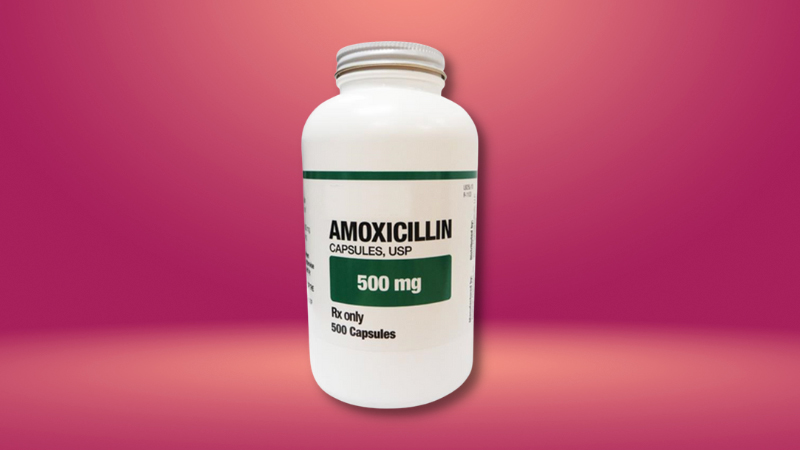
Antibiotics treat or prevent bacterial infections, wiping them and stopping their spread. They don’t work for every kind of bacteria but are highly effective against the most common ones.
The risk of interaction between kratom and antibiotics is moderate to high. There are many different antibiotics, and each has a particular risk when used with kratom.
The main issue is that kratom could attach to the antibiotic and neutralize it, rendering it useless. Additionally, there is a chance one or even both substances could accumulate to harmful levels due to metabolic competition. That risk increases with continued use.
To ensure that everything is absorbed first, you must wait at least 2 hours between taking each substance.
Some common antibiotics include:
- Amoxicillin
- Doxycycline
- Cephalexin
- Ciprofloxacin
- Clindamycin
- Metronidazole
- Azithromycin
- Sulfamethoxazole
- Levofloxacin
Anti-Emetics
Anti-emetics are medications that block the receptors involved with vomiting, thus lessening or stopping nausea and vomiting symptoms. They are used by cancer patients or along with other substances that could potentially cause nausea.
Most anti-emetics and kratom have a modest to moderate risk of interaction. Kratom is an emetic plant, so if you take too much, you may experience nausea. If used with the herb, the anti-emetics can become less effective.
While some people combine anti-emetics with kratom to eliminate the latter’s nauseating side effects, we don’t recommend it. Kratom’s unpleasant side effects serve as a safeguard; without it, there’s a high risk of taking too much and overdosing.
Some common anti-emetics include:
- Aprepitant (Emend)
- Dexamethasone (DexPak)
- Dolasetron (Anzemet)
- Granisetron (Kytril)
- Ondansetron (Zofran)
- Palonosetron (Aloxi)
- Prochlorperazine (Compazine)
- Rolapitant (Varubi)
Antihistamines
Antihistamines are effective medications for relieving allergy symptoms. They mainly reduce or block the inflammatory messenger called histamine. In addition, some medicines keep the mast cells from breaking down, stopping the production of inflammatory cytokines.
Mast cells start a self-destruct cycle and release significant amounts of histamine when we meet an allergy trigger. Histamine is responsible for the allergy symptoms, such as runny nose and eyes, coughing, sneezing, and hives.
There is a moderate amount of risk associated with taking kratom and antihistamines together. Many antihistamines have sedation as a side effect, and the interaction with the herb can potentiate it.
To get high, many people even abuse the antihistamine diphenhydramine, commercially known as Benadryl. Combining kratom with a high dose of Benadryl or other first-generation antihistamines is risky and must be avoided at all costs. The herb could intensify the effects of Benadryl with fatal results.
Some common antihistamines include:
- Carbinoxamine (Palgic)
- Desloratadine (Clarinex)
- Hydroxyzine (Atarax and Vistaril)
- Levocetirizine (Xyzal)
- Brompheniramine (Dimetane)
- Cetirizine (Zyrtec)
- Chlorpheniramine (Chlor-Trimeton)
- Clemastine (Tavist)
- Diphenhydramine (Benadryl)
- Fexofenadine (Allegra)
- Loratadine (Alavert and Claritin)
- Promethazine (Phenergan)
Antipsychotics
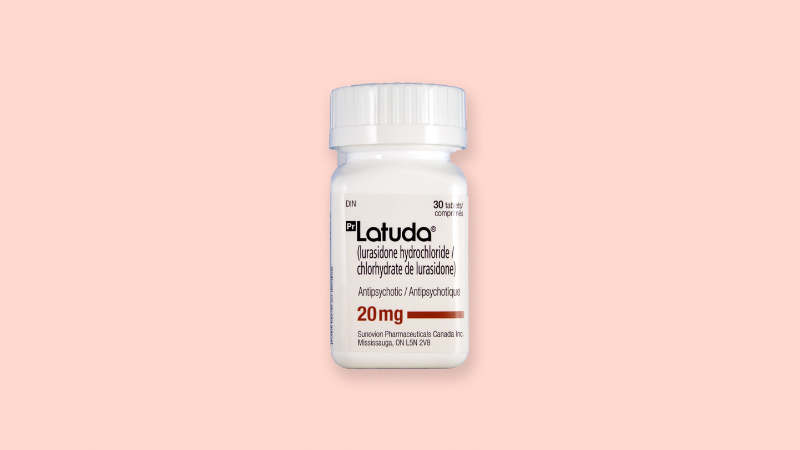
Also known as neuroleptics, antipsychotics treat bipolar disorder, schizophrenia, and other mental disorders. These medications are pretty varied, and physicians frequently try different combinations until finding an effective one.
Do not take kratom with any kind of antipsychotic medication. These drugs have a significant risk of side effects and need cautious titration and dosing. Mixing them with kratom could disturb the neurochemical balance, resulting in hazardous effects.
The principal target of kratom is the CYP2D6 liver enzymes, which are involved in the metabolism of several antipsychotics. These substances could reach hazardous levels if used concurrently.
Some antipsychotics include:
- Blomperidol (Bromidol and Bromodol)
- Clopenthixol (Sordinol)
- Flupentixol (Depixol and Fluanxol)
- Fluphenazine (Prolixin)
- Haloperidol (Haldol)
- Oxyprothepin (Meclopin)
- Perphenazine (Trilafon)
- Pipotiazine (Piportil)
- Zuclopenthixol (Cisordinol and Clopixol)
- Aripiprazole (Abilify)
- Lurasidone (Latuda)
- Olanzapine (Zyprexa)
- Quetiapine (Seroquel)
- Risperidone (Risperdal)
- Ziprasidone (Geodon)
Barbiturates
Barbiturates are sedative and hypnotic medications used to treat many conditions, including seizures and insomnia. They even treat elevated intracranial pressure by inducing a coma and are effective anesthetics.
Despite their efficacy, barbiturates have been superseded by benzodiazepines due to the former’s wide range of receptor types they bind to, causing unintended side effects. For that reason, they are known as “dirty” medications.
Barbiturates and kratom interact negatively, and the risk is moderate to high. These medications aren’t safe even when used alone, and the side effects can be mild to severe.
Kratom increases the chance of a harmful response by altering the balance of brain neurochemicals and competing with barbiturates for liver metabolism.
Some common barbiturates are:
- Amobarbital (Amytal Sodium)
- Butabarbital (Butisol Sodium)
- Mephobarbital (Mebaral)
- Pentobarbital (Nembutal Sodium)
- Phenobarbital (Luminal)
- Secobarbital (Seconal)
Beta-Blockers
Beta-blockers or beta-adrenergic blocking agents lower blood pressure by reducing the heart’s contractile force. They block epinephrine’s effects— adrenaline — and also widen the blood vessels, improving flow.
Beta-blockers and kratom shouldn’t be used together under any circumstances. Kratom counters this drug’s effects by stimulating the adrenergic receptors — blood pressure, heart rate, and contractile force all rise as a result.
Some common beta-blockers include:
- Acebutolol (Sectral)
- Atenolol (Tenormin)
- Betaxolol (Kerlone)
- Bisoprolol Fumarate (Zebeta)
- Carteolol Hydrochloride (Cartrol)
- Metoprolol Tartrate (Lopressor)
- Metoprolol Succinate (Toprol-XL)
- Nadolol (Corgard)
- Penbutolol Sulfate (Levatol)
- Pindolol (Visken)
- Propranolol Hydrochloride (Inderal, InnoPran, and Pronol)
- Sotalol Hydrochloride (Betapace)
- Timolol Maleate (Blocadren)
Benzodiazepines
Benzodiazepines are highly effective sedatives used to treat anxiety and insomnia and can also relax muscles. They increase the effects of GABA, a chemical responsible for reducing brain activity related to reasoning, memory, emotions, and even breathing.
The possibility of a negative interaction between kratom and benzodiazepines is very high. You should never combine these substances without a doctor’s permission. This combination could cause a severe or fatal response.
Continued use of benzodiazepines can lead to addiction. The risk of overdose is minimal when used alone, but it can rise to dangerous levels when mixed with alcohol, kratom, or other substances.
Some common benzodiazepines include:
- Alprazolam (Xanax)
- Chlordiazepoxide (Librium)
- Clonazepam (Klonopin)
- Clorazepate (Tranxene)
- Diazepam (Valium)
- Estazolam (Prosom)
- Flurazepam (Dalmane)
- Lorazepam (Ativan)
- Midazolam (Versed)
- Oxazepam (Serax)
- Temazepam (Restoril)
- Triazolam (Halcion)
- Quazepam (Doral)
Blood Thinners

Blood thinners promote easy blood flow through veins and arteries. Additionally, they prevent blood clots from growing or developing. They can treat many cardiac disorders, including congenital heart problems.
Blood thinners and kratom have a moderate potential of having adverse side effects. You should talk to your doctor before taking kratom if you’re using these medications.
Kratom acts like a metabolic competitor and could lead to a dangerous build-up of blood thinners in the bloodstream. For instance, Warfarin is already hard for the body to eliminate on its own, and kratom could make matters even worse.
Moreover, kratom can have hypotensive or hypertensive effects depending on the dosage and strains utilized. Its combination with hypotensive blood thinners could cause feelings of lightheadedness or dizziness due to extremely low blood pressure.
If the kratom dose causes an increase in blood pressure, the chance of a heart attack or stroke increases, causing a potentially dangerous situation for those already at risk.
Some common blood thinner medications include:
- Apixaban (Eliquis)
- Dabigatran (Pradaxa)
- Enoxaparin (Lovenox)
- Rivaroxaban (Xarelto)
- Warfarin (Coumadin & Jantoven)
- Clopidogrel (Plavix)
Biguanides
Biguanides are a type of medication created to treat type 2 diabetes, among other conditions. They mainly reduce the production of glucose during digestion. Metformin is the most common biguanide available in the global market.
Kratom is unlikely to cause any significant interaction with biguanides like Metformin. The main risk could come from metabolic competition, but a simple way to avoid it is to take them at least two hours apart.
Nevertheless, people who use Metformin should not take kratom daily and should discuss it with their doctor first.
Some common biguanide medications include:
- Metformin (Glucophage)
- Canagliflozin (Invokana)
- Dapagliflozin (Farxiga)
- Saxagliptin (Onglyza)
- Empagliflozin (Jardiance)
- Linagliptin (Tradjenta)
- Ertugliflozin (Steglatro)
Calcium Channel Blockers
Calcium channel blockers reduce the heart’s contractile force by limiting calcium’s ability to enter the muscle cells. Each muscle cell uses calcium to make the muscles contract and relax. The change in contractile force helps against hypertension and cardiac damage.
We don’t recommend taking kratom if you use calcium channel blockers. Kratom’s ability to stimulate the cardiac muscle and boost contractile force would negate the benefits of this drug.
The conditions treated by this medication are severe. Therefore, do not take this combination unless your physician says it’s safe.
Some common calcium channel blockers include:
- Amlodipine (Norvasc, Lotrel)
- Bepridil (Vasocor)
- Diltiazem Hydrochloride (Cardizem CD, Cardizem SR, Dilacor XR, Tiazac)
- Felodipine (Plendil)
- Isradipine (DynaCirc, DynaCirc CR)
- Nicardipine (Cardene SR)
- Nifedipine (Adalat CC, Procardia XL)
- Nisoldipine (Solar)
- Verapamil Hydrochloride (Calan SR, Covera HS, Isoptin SR, Verelan)
Central Agonists
Central agonists, also known as central adrenergic inhibitors, are medications that decrease blood pressure and heart rate. They block the signals that change the heart rate and constrict blood vessels so the heart pumps more lightly and blood flows smoothly.
When taken with central agonists, kratom carries a moderate danger due to its ability to raise or lower blood pressure. Depending on the dosage and strain, this combination could hinder the medication’s effects or potentiate them to dangerous levels.
Either way, you shouldn’t take kratom with central agonists. If you’re still unsure, don’t hesitate to discuss it with your doctor.
Some common central agonists include:
- Alpha Methyldopa (Aldomet)
- Clonidine Hydrochloride (Catapres)
- Guanabenz Acetate (Wytensin)
- Guanfacine Hydrochloride (Tenex)
Diuretics
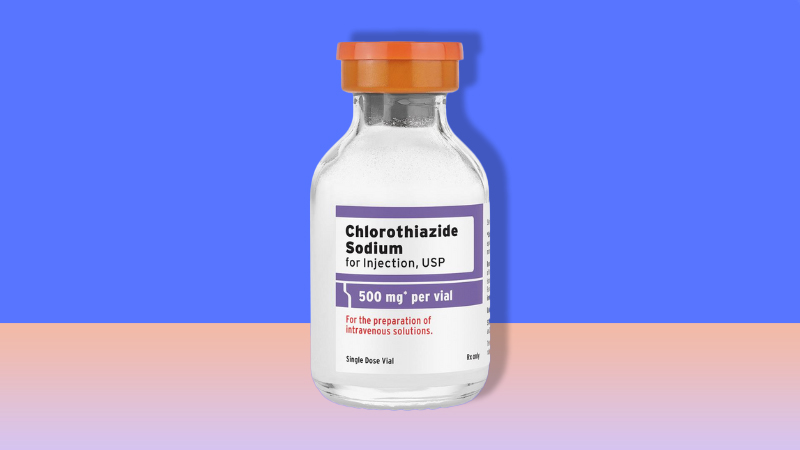
Diuretics are substances that help the kidneys eliminate water and salt through urine. Carrying less fluid in the veins and arteries decreases blood pressure. In turn, the heart doesn’t have to pump as hard, letting it rest.
The interaction between kratom and diuretics is considered low risk, with a few rare exceptions. Nevertheless, the herb could make the diuretic more effective, which might cause problems with low blood pressure or dehydration.
Moreover, kratom can prevent the metabolism of the diuretic and, as a result, raise serum blood levels. Diuretic medications can harm the liver or kidneys if they are too concentrated.
If you have been taking diuretics, you should discuss kratom with your doctor before trying it. To compensate for the decreased metabolism brought on by kratom, they might be able to alter your dose appropriately.
Furthermore, it’s a good idea to refrain from taking kratom daily when using this combo. That way, your body can metabolize the diuretic without needing to worry about adverse side effects.
Some common diuretics include:
- Chlorthalidone (Hygroton)
- Chlorothiazide (Diuril)
- Hydrochlorothiazide (Esidrix, Hydrodiuril & Microzide)
- Indapamide (Lozol)
- Metolazone (Mykrox & Zaroxolyn)
- Amiloride Hydrochloride (Midamar)
- Spironolactone (Aldactone)
- Triamterene (Dyrenium)
- Furosemide (Lasix)
- Bumetanide (Bumex)
Dipeptidyl Peptidase-4 (DPP-4) Inhibitors
DPP-4 inhibitors are a medication used to treat type 2 diabetes. They block the enzyme DPP-4, thus preventing the destruction of incretins and, in turn, aiding in the production of insulin. As a result, patients with diabetes experience lower blood sugar levels after meals.
Although the severity of their interaction is considered minimal, if you’ve taken DPP-4 or any other anti-diabetic medication, you should always talk to your doctor before using kratom.
Kratom could interact with DPP-4 inhibitors by impeding the liver’s capacity to metabolize them adequately. Repeated use of the combination might result in excessive amounts of insulin in the body, causing low blood sugar levels and other metabolic issues.
Some common DPP-4 inhibitors include:
- Alogliptin (Nesina, Kazano, Oseni)
- Linagliptin (Tradjenta, Glyxambi, & Jentadueto)
- Saxagliptin (Onglyza, Kombiglyze XR)
- Sitagliptin (Januvia, Janumet, & Juvisync)
GLP-1 Receptor Agonists
Glucagon-like peptide-1 or GLP-1 is a hormone responsible for the production and release of insulin. GLP-1 receptor agonists mimic its actions and stimulate that release, leading to lower blood sugar levels essential to treat type 2 diabetes.
Kratom isn’t involved in the metabolism and elimination of these medications, so the risk of a harmful interaction is low.
Some common GLP-1 receptor agonists include:
- Albiglutide (Tanzen)
- Dulaglutide (Trulicity)
- Exenatide (Byetta, Bydureon)
- Liraglutide (Victoza)
- Semaglutide (Ozempic)
Immunosuppressants
The purpose of immunosuppressant medications is to reduce the strength of the immune system. While some keep the body from rejecting a transplanted organ, others serve to treat autoimmune diseases like lupus or psoriasis.
If you use immunosuppressants, you should never combine them with kratom. The herb’s properties could stop the immunosuppressant medications from working.
Though relatively unknown, kratom has the potential to control or make changes to the immune system. Studies suggest that the plant’s main alkaloids may either potentiate or suppress several immune system functions.
Immunosuppressive drugs treat severe diseases. Thus, anything that can impair their effectiveness should be avoided at all costs.
Some common immunosuppressants include:
- Azathioprine (Imuran)
- Mycophenolate Mofetil (Cellcept)
- Cyclosporine (Neoral, Sandimmune, Gengraf)
- Methotrexate (Rheumatrex)
- Leflunomide (Arava)
- Prednisone (Deltasone)
- Cyclophosphamide (Cytoxan)
- Chlorambucil (Leukeran)
- Nitrogen Mustard (Mustargen)
Insulin
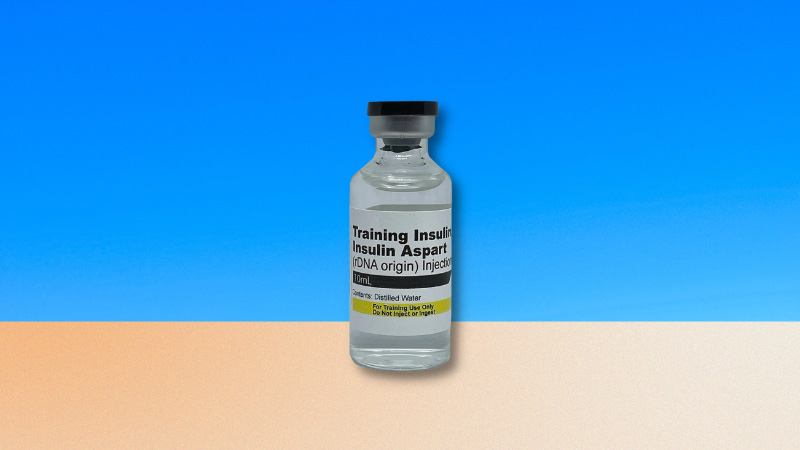
Insulin is the hormone that commands the body to absorb glucose — a type of sugar — in the bloodstream and turn it into energy. When the body doesn’t produce enough insulin to absorb and keep glucose levels down, it needs to get it from a medication.
Kratom and insulin are unlikely to interact negatively. The two substances don’t have much in common and don’t seem to be dangerous in terms of metabolism or impact.
Animal research indicates that kratom could be slightly hypoglycemic, but this effect hasn’t been verified in humans yet. Nevertheless, it might intensify the hypoglycemic effects of insulin, resulting in lightheadedness and fainting.
To reduce the possibility of this interaction, we recommend waiting at least two hours between taking insulin and kratom. To avoid hazardous interactions with insulin or other medications, talk with your doctor about your kratom usage.
Some common insulin medications include:
- Insulin Aspart (NovoLog, FlexPen, Fiasp)
- Insulin Glulisine (Apidra)
- Insulin Lispro (Humalog)
- Insulin Isophane (Humulin N, Novolin N)
- Insulin Degludec (Tresiba)
- Insulin Detemir (Levemir)
- Insulin Glargine (Lantus, Toujeo)
MAO Inhibitors
Monoamine oxidase inhibitors (MAOIs) were the first modern antidepressants in history. They change the brain chemistry by affecting the neurotransmitters that send messages between brain cells. While safer medications have superseded them, they remain effective against depression.
It’s not safe to take kratom while using MAO inhibitors. They require exact titration and balance between the amount taken daily and the one metabolized by the liver.
The alkaloids of kratom can modify that fragile balance and cause the MAO inhibitors to build up in the bloodstream. If they reach a toxic level, the side effects will be severe.
Some common MAO inhibitors include:
- Isocarboxazid (Marplan)
- Phenelzine (Nardil)
- Selegiline (Emsam)
- Tranylcypromine (Parnate)
Meglitinides
Meglitinides function by inducing the release of insulin from the pancreas in response to a meal. They are used to treat type 2 diabetes.
The combination of kratom and meglitinides has a low chance of producing a severe response. However, kratom could interfere with the body by eliminating this medication.
Moreover, kratom could intensify the hypoglycemic effects of the meglitinides, which might cause lightheadedness or fainting. They should be taken separately at least 2 hours apart to prevent those side effects.
Some common meglitinide medications include:
- Nateglinide (Starlix)
- Repaglinide (Prandin, Prandimet)
NDRI Medications
NDRIs or norepinephrine-dopamine reuptake inhibitors are a type of drug created to treat depression, ADHD, narcolepsy, and Parkinson’s disease. They raise blood concentrations of dopamine and norepinephrine by preventing their reuptake in the brain.
Regarding metabolism and elimination, kratom is unlikely to compete with NDRI medications. These employ the CYP2B6 metabolic route, which doesn’t conflict with kratom, so there’s no risk of slowed elimination.
The only exception is Bupropion because it uses the CYP2D6 pathway, also used by kratom, resulting in a metabolic competition.
Some common NDRI medications include:
- Bupropion (Budeprion, Buproban, Wellbutrin & Zyban)
- Amineptine (Survector, Maneon, Directim)
- Desoxypipradrol (2-DPMP)
- Dexmethylphenidate (Focalin)
- Difemetorex (Cleofil)
- Diphenylprolinol (D2PM)
- Ethylphenidate
- Fencamfamine (Glucoenergan, Reactivan)
- Fencamine (Altimina, Sicoclor)
- Lefetamine (Santenol)
- Methylenedioxypyrovalerone (MDPV)
- Methylphenidate (Ritalin, Concerta, Metadate, Methylin, Rubifen, Stimdate)
- Nomifensine (Merital)
- O-2172
- Phenylpiracetam (Phenotropil, Carphedon)
- Pipradrol (Meretran)
- Prolintane (Promotil, Katovit)
- Pyrovalerone (Centroton, Thymergix)
- Solriamfetol (Sunosi)
- Tametraline (CP-24,411)
- WY-46824
NSAID Painkillers

NSAID stands for non-steroidal anti-inflammatory drug and is a class of painkillers that includes some of the most well-known medications in the world. They are very effective and can also reduce fever and swelling.
Kratom and NSAIDs are likely to cause an interaction, but it isn’t of concern as long as they are used within reasonable levels. However, they could harm the liver or cause stomach or duodenal ulcers if used irresponsibly.
Additionally, some NSAIDs will compete with kratom for metabolism in the liver, which might increase their levels in the bloodstream. In the long term, those levels could become toxic and cause adverse effects.
Don’t use kratom if taking prescription NSAIDs without first talking to your doctor.
Some common NSAID painkillers include:
- Aspirin (Ascriptin, Aspergum, Entercote)
- Acetaminophen (Tylenol)
- Ibuprofen (Motrin, Advil, Nuprin, Caldolor & Neoprofen)
- Celecoxib (Celebrex & Onsenal)
- Naproxen (Aleve)
- Ketorolac (Toradol)
- Etodolac (Ultradol)
- Meloxicam (Mobic)
Opiate & Opioid Painkillers
Opiates and opioid painkillers are narcotic medications used to relieve severe pain. Opiates come from natural sources, while opioids are synthetic. Because of their potency and addictive potential, the only way for people to obtain them is through a doctor’s prescription.
You should never combine kratom with opiates or opioid painkillers of any kind. The side effects of such a combination could be fatal.
Kratom and opioids target the same receptors; using both simultaneously potentiate their effects to a dangerous level, and the chances of overdosing skyrocket.
Some common opiate and opioid painkillers include:
- Buprenorphine (Cizdol & Brixadi)
- Codeine
- Diamorphine (Heroin)
- Pethidine (Meperidine & Demerol)
- Fentanyl (Abstral & Actiq)
- Hydrocodone (Hysingla ER, Zohydro ER & Hycodan)
- Hydrocodone & Paracetamol (Vicodin)
- Hydromorphone (Dilaudid)
- Methadone (Methadose & Dolophine)
- Morphine (Kadian & Roxanol)
- Oxycodone (Percodan, Endodan, Roxiprin, Percocet, Endocet, Roxicet & OxyContin)
- Tramadol (Ultram, Ryzolt & ConZip)
PDE5 Inhibitors
Phosphodiesterase type 5 — also known as PDE5 — inhibitors are a class of medications currently used to treat erectile dysfunction caused by physiological factors. They enhance blood flow to the penis, leading to better erections.
While unlikely, combining kratom with PDE5 inhibitors could cause harm to the brain, heart, or arteries. Don’t use kratom if you’ve taken any of these medications for the last three days.
Some common PDE5 inhibitors include:
- Avanafil (Stendra)
- Mirodenafil (Mvix)
- Sildenafil (Viagra)
- Tadalafil (Cialis)
- Udenafil (Zydena)
- Vardenafil (Levitra, Staxyn, and Vivanza)
Peripheral Adrenergic Inhibitors
Peripheral adrenergic inhibitors are another class of medications used to reduce blood pressure. They block the adrenergic receptors outside the brain, causing veins and arteries to relax.
The interaction between kratom and the peripheral adrenergic inhibitors could render each other ineffective. That’s because many kratom alkaloids are agonists to the adrenergic receptors, which would counteract the medication’s effects and raise blood pressure.
Some common peripheral adrenergic inhibitors include:
- Guanadrel (Hylorel)
- Guanethidine Monosulfate (Ismelin)
- Reserpine (Serpasil)
Proton Pump Inhibitors (PPIs)
Proton pump inhibitors (PPIs) are medicines whose purpose is to reduce the amount of stomach acid in the stomach, relieve symptoms of reflux, and treat gastric ulcers.
PPIs and kratom are processed by different liver enzymes and have distinct mechanisms of action, so they are unlikely to interact.
However, kratom may remain undigested for a long time due to the PPIs making digestion harder. This could prolong the time it takes for kratom’s effects to become active and increase the risk of gastric issues.
Some common PPIs include:
- Pantoprazole (Protonix)
- Ranitidine (Zantac)
- Omeprazole (Prilosec, Prilosec OTC, Zegerid)
- Lansoprazole (Prevacid)
- Rabeprazole (Aciphex)
- Esomeprazole (Nexium)
- Dexlansoprazole (Dexilant)
SARI Medications
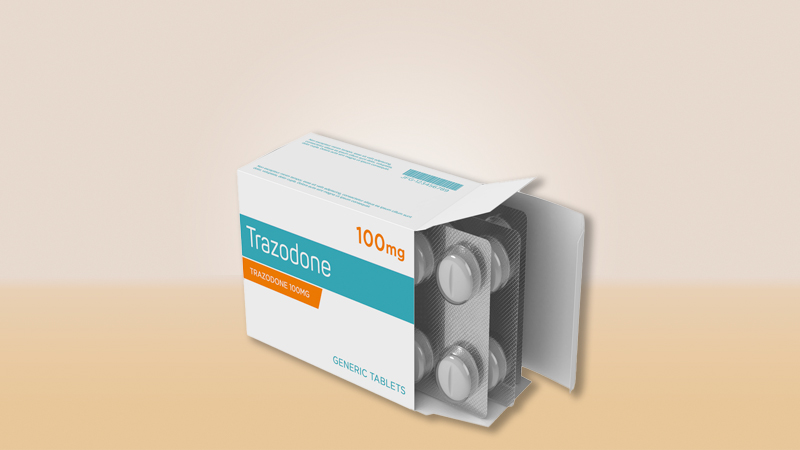
Serotonin antagonists and reuptake inhibitors (SARIs) are a class of antidepressants. They increase the amount of serotonin in the nervous system and inhibit the 5HT2a receptor. As a result, they can lessen symptoms of depression, anxiety, and insomnia.
Kratom may affect how SARI medicines are metabolized and eliminated, resulting in a dangerous accumulation of serotonin. When this occurs, it may cause a disease known as serotonin syndrome, which can be deadly if untreated.
Furthermore, SARIs have headaches and nausea as side effects, which are also frequent with kratom. Combining these drugs could potentiate them.
Some common SARI medications include:
- Trazodone (Desyrel & Oleptro)
- Nefazodone (Serzone)
SDAM Medications
Serotonin-dopamine activity modulators (SDAMs) treat schizophrenia and bipolar disorder. They improve symptoms by inducing changes in the activity of dopamine and serotonin, which take part in regulating mood and emotions.
We strongly advise against combining kratom and SDAMs. Depending on the dosage, kratom could either intensify the sedative effect of these medications or counteract it. In addition, it could increase their levels in the body by preventing their metabolism and elimination.
In the end, any drug that dramatically alters the balance of neurotransmitters should only be used with extreme caution. Both substances impact neurochemistry, so we don’t recommend using them together without a doctor’s supervision.
Some common SDAM medications include:
- Brexpiprazole (Rexulti)
- Lumateperone (Caplyta)
- Olanzapine/Samidorphan (Lybalvi)
SNRI Medications
SNRI refers to serotonin and norepinephrine reuptake inhibitor. They are antidepressants that increase serotonin and norepinephrine in the brain. Due to blocking their reabsorption, these medications stabilize mood and emotions.
When used simultaneously, there is a significant risk of a harmful interaction between kratom and SNRI drugs. Side effects could include headaches, sleeplessness, irritability, mood swings, nausea, and more.
Though it uses a different process, kratom also raises serotonin and norepinephrine levels in the brain. Using them together could worsen the side effects of both substances.
Some common SNRI medications include:
- Atomoxetine (Strattera)
- Desvenlafaxine (Pristiq, Khedezla)
- Duloxetine (Cymbalta, Irenka)
- Levomilnacipran (Fetzima)
- Milnacipran (Savella)
- Venlafaxine (Effexor XR)
SSRI Medications
SSRIs are a class of antidepressants used to treat moderate to severe cases of depression. Known as selective serotonin reuptake inhibitors, they increase serotonin levels in the brain and block its reabsorption into the cells, improving communication between neurons.
When used with SSRI drugs, kratom poses a low to moderate level of risk. There are many reports of people using kratom alongside SSRIs without experiencing problems, but there is still a potential for an adverse response.
Kratom could conflict with the metabolism of SSRIs, which require that the dosage taken corresponds to the metabolized amount. If kratom disturbs this delicate balance, the SSRIs may accumulate, eventually leading to serotonin syndrome, which can be deadly.
Some common SSRI medications include:
- Citalopram (Cipramil & Celexa)
- Dapoxetine (Priligy)
- Escitalopram (Cipralex & Lexapro)
- Fluoxetine (Prozac, Rapiflux, Sarafem, Selfemra & Oxactin)
- Fluvoxamine (Faverin)
- Paroxetine (Seroxat)
- Sertraline (Zoloft, Lustral)
- Vortioxetine (Brintellix)
SGLT-2 Inhibitors
SGLT-2 inhibitors prevent blood sugar — glucose — from getting reabsorbed into the kidneys, letting the body eliminate it through urination. They are an alternative way to deal with type 2 diabetes and high blood sugar levels.
As this type of medication is relatively new, there’s little information about its safety, at least in the long term. So far, we don’t expect kratom and SGLT-2 drugs to interact in a significant way, but you should nevertheless talk with your doctor before using both at the same time.
Some common SGLT-2 inhibitors include:
- Dapagliflozin (Farxiga & Xigduo XR)
- Canagliflozin (Invokana, Invokamet)
- Empagliflozin (Jardiance, Glyxambi, Synjardy)
- Ertugliflozin (Steglatro)
Statin Drugs
Statin medications help against high cholesterol in the blood. They block the function of the HMG-CoA enzyme responsible for synthesizing cholesterol. As a result, they lower their levels in the bloodstream, which can cause a narrowing of the blood vessels if left untreated.
So far, there have been no reports of this interaction leading to any issues. However, kratom could compete with statin drugs for the CYP3A4 metabolic route. The body might take a longer time to eliminate both substances, leading to accumulation in the long term.
Therefore, if you have been prescribed statin drugs, we advise talking to your physician before using kratom.
Some common statin medications include:
- Atorvastatin (Lipitor)
- Lovastatin (Altoprev)
- Pitavastatin (Livalo, Zypitamag)
- Pravastatin (Pravachol)
- Rosuvastatin (Crestor & Ezalor)
- Simvastatin (Zocor)
Stimulants
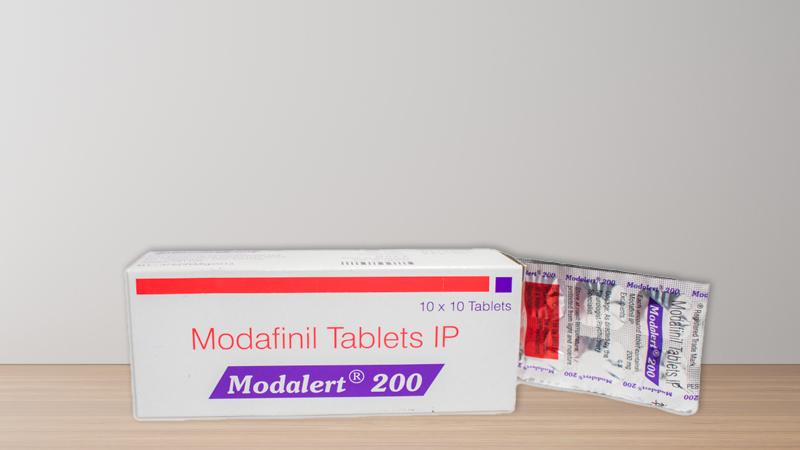
Stimulant medications boost the levels of hormones like dopamine and norepinephrine, among others. They are beneficial for treating conditions like ADHD because they improve concentration and reduce fatigue.
There is no reason to combine kratom with stimulant medications. In low amounts, kratom is a stimulant, and its interaction with these medicines could lead to severe side effects. At worst, the combination could cause cardiac injuries, nerve damage, and even seizures.
Some common stimulants include:
- Amphetamine (Adderall, Adzenys ER, Mydayis)
- Lisdexamfetamine dimesylate (Vyvanse)
- Dextroamphetamine Sulfate (Zenzedi & Dexedrine)
- Methylphenidate (Ritalin)
- Atomoxetine (Strattera)
- Methamphetamine (Desoxyn, Methedrine)
- Modafinil (Provigil & Nuvigil)
- MDMA (Ecstasy)
- Nicotine (Habitrol, Nicoderm CQ, Nicotrol)
- Cocaine (Erythroxylum coca)
Tricyclic Antidepressants (TCAs)
Tricyclic antidepressants, currently known as cyclic antidepressants, were some of the first antidepressants in history. Created in the 1950s, they are effective at keeping more serotonin and norepinephrine in the brain, but they also have many side effects.
Kratom has a high chance of interacting negatively with TCAs. The herb can potentiate the medication’s side effects, which often include nausea, headaches, dizziness, and seizures. In extreme circumstances, you could end up with serotonin syndrome.
Some typical tricyclic antidepressants include:
- Amitriptyline (Elavil)
- Amoxapine (Asendin)
- Desipramine (Norpramin)
- Doxepin (Sinequan, Quitaxon & Aponal)
- Imipramine (Tofranil)
- Nortriptyline (Pamelor)
- Protriptyline (Vivactil)
- Trimipramine (Surmontil)
One atypical tricyclic antidepressant is:
- Tianepine (Stablon, Coaxial)
Z-Drugs
Z-drugs, also known as nonbenzodiazepines, are a type of medication with effects similar to benzodiazepines but with an entirely different chemical structure. They are mainly used to treat insomnia.
Though the risk of interaction between kratom and Z-drugs is low, taking them together is not safe. The interaction could be agonistic, meaning kratom would intensify the Z-drugs’ sedative effect. Side effects could include memory loss and seizures.
Regarding metabolic function, most Z-drugs don’t stress the CYP450 enzymatic system, so the risk of competition with kratom is low. However, a few others, like zopiclone, use that family of enzymes, and the interaction could result in slowed elimination and accumulation over time.
Some common Z-drugs include:
- Alpidem (Ananxyl)
- Necopidem
- Saripidem
- Zolpidem (Ambien)
- Zopiclone (Imovane)
Conclusion: Kratom Drug Interactions
Kratom is not a harmful herb. Millions use it safely every day and enjoy its numerous benefits. Nevertheless, it has side effects that, while not severe when taken alone, could become dangerous when interacting with certain substances.
Taking kratom with substances like orange juice is harmless, but many other combinations could significantly impact the nervous system and the metabolic processes in the liver. At best, the side effects are mild, but at worst, it could result in death.
In the end, you should never take kratom if you already use a medication without at least talking to a doctor. Especially avoid combinations with narcotics and antipsychotics, as they are more likely to have fatal results.
References
- Arimoto, R. (2006). Computational models for predicting interactions with cytochrome p450 enzyme. Current topics in medicinal chemistry, 6(15), 1609-1618. [1]
- Hanapi, N. A., Ismail, S., & Mansor, S. M. (2013). Inhibitory effect of mitragynine on human cytochrome P450 enzyme activities. Pharmacognosy research, 5(4), 241. [2]
- List Kamble, S. H., Sharma, A., King, T. I., Berthold, E. C., León, F., Meyer, P. K. L., … & Avery, B. A. (2020). Exploration of cytochrome P450 inhibition mediated drug-drug interaction potential of kratom alkaloids. Toxicology letters, 319, 148-154. [3]
- Przemys³aw Niewiñski, Ewa Jaÿwiñska-Tarnawska, Krystyna Orzechowska-Juzwenko, Henryk Czarnik-Matusewicz (2007). Orange juice has no effect on CYP2D6-dependent drug metabolism. Pharmacological Report nº59 for the Wroclaw Medical University, PL 50-345. [4] https://www.researchgate.net/publication/228512358_Orange_juice_has_no_effect_on_CYP2D6-dependent_drug_metabolism
- Sarah L Hulin-Curtis, Dominique Petit, W Douglas Figg, Ann W Hsing, Juergen KV Reichardt (2010). Finasteride metabolism and pharmacogenetics: new approaches to personalized prevention of prostate cancer. Future Oncology 6(12): 1897–1913. [5]